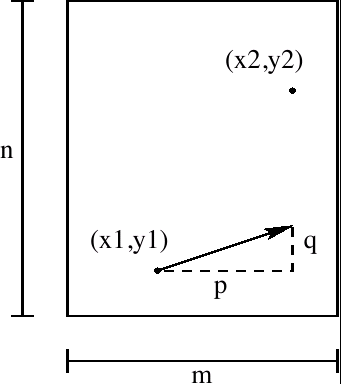
| Rational Billiard |
The International Billiard Manufactory (IBM) builds the best billiard tables in the world. Its last product is the Rational Billiard, which is a friction-less table with volume-less balls. This means that balls just occupy a point in the space, and once they are struck with the cue, they move on the table with constant velocity, until they hit another ball.
IBM wants you to build a program to analyse the behavior of balls in the Rational Billiard. The program has to decide whether a ball,
struck with certain angle, will hit another ball in certain position. The next figure shows the configuration of the table and the balls:

m and n are integer values that indicate the size of the table.
(x1, y1) and
(x2, y2) are the coordinates of the first
and second ball respectivelly, with
0 < x1, x2 < m and
0 < y1, y2 < n. The direction in which the first ball is struck is
determined by the integer values p and q. More precisely, the slope
![]() determines the hitting direction of the cue, where p and q
cannot be zero simultaneously. A value of p = 0 means that the ball moves parallel to the vertical axis, according to the sign of q. When the
ball hits an edge, it rebounds like if the edge were a mirror (
incidence angle = reflection angle). In the special case when the ball hits a corner,
it is reflected on the same line but in the opposite direction of arrival. Finally, spin effects are neglected, too.
determines the hitting direction of the cue, where p and q
cannot be zero simultaneously. A value of p = 0 means that the ball moves parallel to the vertical axis, according to the sign of q. When the
ball hits an edge, it rebounds like if the edge were a mirror (
incidence angle = reflection angle). In the special case when the ball hits a corner,
it is reflected on the same line but in the opposite direction of arrival. Finally, spin effects are neglected, too.
Each line in the input corresponds to a test case specified by eight integer values:
m, n, x1, y1, x2, y2, p and q, with
0 < m, n![]() 1000,
0 < x1, x2 < m,
0 < y1, y2 < n,
-1000
1000,
0 < x1, x2 < m,
0 < y1, y2 < n,
-1000![]() p, q
p, q![]() 1000, and
| p| + | q| > 0.
1000, and
| p| + | q| > 0.
The end of the input is specified by a line with the string ``0 0 0 0 0 0 0 0''.
For each test case, the program must output a line with the the text ``HIT'' if the first ball hits the second ball, or ``MISS'' if it does not.
4 4 3 1 1 1 1 1 4 4 3 1 2 2 1 1 0 0 0 0 0 0 0 0
HIT MISS